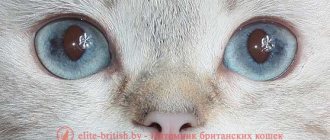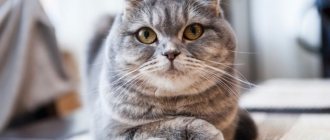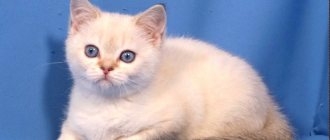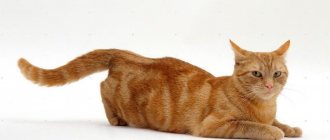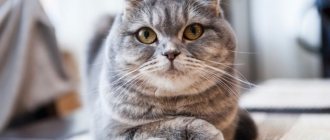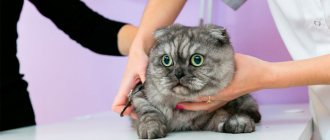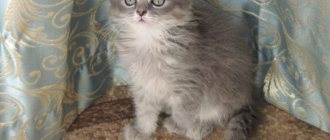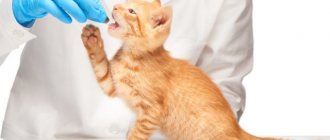History of the Scottish Straight cat breed
Scottish Straight cat
Scottish Straight are the same Scottish folds, but with a modified position of the ear. Straight ears do not have a characteristic crease and are set straight, and this, in fact, is the only external sign that distinguishes them from their fold-eared counterparts. Scottish cats are considered one of the youngest cat breeds. The first cat with an unusual, flattened ear shape appeared on a Scottish farm in the early 60s. Surprisingly, the ancestor of modern folds and straights had no pedigree and simply chased mice through the barns of local peasants.
The first official Scottish breeder was an ordinary villager, William Ross, who adopted a kitten from the aforementioned Fold. A few years later, professional breeders also joined the process. At the same time, experts witnessed an interesting phenomenon: in the litters brought by even the most purebred Scottish dogs, babies with erect ears appeared. Of course, no one intended to separate such individuals into a separate breed. And kilometer-long queues did not line up for straight-eared kittens, because against the backdrop of touching folds, they were outright losing. But here nature itself intervened.
Very soon, Scottish breeders noticed that attempts to strengthen and strengthen the lop ears of animals had a negative impact on their health. The mutated gene responsible for the flatness of the ear folds began to inhibit the function of the skeletal apparatus of cats. As a result, the Scots began to suffer from thickening of the bones and osteochondrodysplasia. To keep the breed afloat, breeders rushed to look for “new blood” that would help the Scottish survive and reduce the number of their genetic defects. Through trial, error and outcrossing, it was discovered that the healthiest and most beautiful offspring can be obtained from crossing a Fold cat and a straight-eared male of the same breed. It was thanks to this discovery that breeders and felinological associations finally turned their attention to straight-eared Scots. Well, in 2004, the Scottish Straight subspecies received official recognition from the World Cat Federation and the status of an independent breed, which sharply increased the attractiveness of straight-eared cats in the eyes of potential buyers.
Caring for Scottish Straight cats
The Scottish Straight cat does not require any particularly complex care. And usually there are no problems with its content. But, like every pet, she needs some hygiene procedures.
The Scottish Straight needs to be brushed once or twice a week. Firstly, to prevent the fur from getting tangled. Secondly, make sure that the cat does not eat too much hair during the licking process, as this can cause digestive problems. This is one of the characteristics of this breed. In addition, it is necessary to give cats a special paste so that the hair leaves the body.
It is enough to wash your Scottish Straight once a month.
It is necessary to check your ears regularly. Clean carefully with cotton swabs and lubricate with cream.
Must be clean, clear, and not watery. If problems arise, you need to take your cat to the vet.
The Scottish cat's nails need to be trimmed periodically. Only the transparent part is cut off. The most convenient way to perform this operation is with special nail clippers, which can be purchased at any pet store, and then treat your fingers with peroxide.
And, of course, you need to regularly show your furry pet to the veterinarian so that he can check the cat’s health, including its teeth. And get all the necessary vaccinations. Give anthelmintic drugs for prevention once every six months. And in the warm season, if the animal is taken to the country, treat it with special preparations against ticks and fleas.
We invite you to familiarize yourself with Feeding calves: diet for different ages, use of milk replacer
A special litter for the cat's litter box will get rid of the specific smell, but nevertheless, you need to clean up after the cat and wash the tray with a cleaning agent (preferably odorless and then rinse with clean water - the cat may not like the smell of the detergent). Scottish Straights, like other cats, are very clean.
Appearance of the Scottish Straight
Scottish Straights can easily be confused with the British, although representatives of these two breeds have a minimum of common genes. Scottish Straight cats are much smaller than their competitors from Albion, although they have a longer body. The weight of an average straight is 3-3.5 kg. Modern breeders are still wondering what kind of offspring they will get after mating a fold and a straight, since initially all kittens are born with ordinary ears, which change their position only at the end of the first month of life.
Head
Mustachioed Scotsman
According to the WCF standard, Scottish Straights must have a rounded skull. Representatives of this breed have convex foreheads and cheeks. In cats, the area of the cheekbones and cheeks is noticeably more rounded than in cats. The chin of the Scots is firm, rounded, but does not protrude forward. The whisker pads are distinguished by their characteristic “swelling” and have the shape of a regular oval.
Nose
Wide and short, with a slight arch of the back and a pronounced base, practically without a stop.
Eyes
Large and round, widely spaced. The gaze is open, inquisitively focused. Eye color depends on the coat color of the animal.
Ears
Erect, small, with a wide base. The tips of the ears are rounded and point forward. The outer part of the ear is covered with thick, close-fitting hair. The inner part is decorated with lush and stiff hair brushes extending beyond the edge of the ear.
Neck
The Scottish Straight cat has a muscular and short neck.
Scottish Straight muzzle
Frame
Moderately long, muscular and wide, tending to the rectangular type. The silhouette line is soft and rounded.
Limbs
Proportional to the body, that is, moderately long and strong, with developed muscles. The paws are oval, the toes are tightly clenched.
Tail
Medium or long, mobile, reaching to the middle of the shoulder blades.
Wool
Scottish Straight tabby color
Short or semi-long (in Highland individuals). Double, plush type, with well-developed undercoat. It does not adhere to the body, but covers it tightly. The texture of the coat may vary slightly depending on the season, as well as the type of color of the animal.
Color
The standard allows all types of colors found among representatives of this breed. The most typical color options for Scottish Straight cats are solid, bicolor, point, tabby, particolor, chinchilla, ticked, van and shedded.
Defects in appearance and disqualifying defects
Individuals with semi-erect or too wide ears with a British set are considered not the most successful representatives of their breed. The flat forehead, pronounced stop, long legs and small eyes of the Scottish Straight are also not decorative. Animals with an insufficiently long, inactive and kinked tail, cryptorchidism and everted toes are subject to unconditional disqualification. Weak and sick cats are also not allowed to participate in exhibition events.
Kittens from a Scottish Fold cat, with an average of five straight-eared and one fold-eared
Eye care
A mandatory procedure for caring for the eyes of a British kitten is to examine them and wipe them with a special swab, which must first be moistened in water or a special liquid.
Such simple procedures will help eliminate infection and eye diseases that are typical for representatives of this breed. You need to clean the eye by wiping it from the outer corner and towards the nose.
In this case, it is necessary to avoid strong pressure. A peculiarity of Scottish cats is that their eyes are very watery due to the fact that they have a narrowed shape, so it is necessary to regularly clean the tear ducts. Under no circumstances should you allow non-transparent tears to appear , as this is the main sign of eye infection. In this case, you should definitely contact a veterinarian and follow all his recommendations in order to ensure a quick recovery.
Scottish Straight character
It would be a big mistake to label all Scottish Straights as phlegmatic philosophers. Moreover, among these imposing cats, sometimes there are real livelies who love to chase a wind-up mouse and measure their strength with the owner. And yet, for the most part, Scottish straight cats do not have a violent temperament. Proud and serious, they cannot stand total control and are unlikely to allow themselves to be squeezed into a semi-conscious state. This, of course, does not make Scottish ascetics and sad hermits, they just require a little more independence and personal space than representatives of other breeds. Straights prefer to spend their free time in peace and quiet, lounging on the couch and learning Zen in the Buddha pose.
Squeezing the cat
The Scots are happy to make contact and join in the games, but only when they want to. In all other cases, it is better to leave the cat alone. The peak of motor activity of straight-eared Scottish cats occurs in the first year of their life. By the way, Scottish babies in their playfulness and restlessness are practically no different from ordinary outbred kittens. Adults, on the contrary, are famous for their exemplary behavior and patience. If you go on a visit for a couple of hours, leaving the Straight alone, he will easily survive it. However, weeks of loneliness, interrupted by rare raids from the owner, will not improve the character of the animal. As for the pacifying purr of straight-eared Scottish cats, it still needs to be earned: cats purr infrequently, and meow only in exceptional, from their own point of view, cases. Scottish Straights accept strangers and noisy groups of guests in a completely “secular” way, which means without unnecessary suspicion and aggression, but also without wild delight.
Scottish Straight cats are emotionally stable and not subject to sudden mood swings. However, exceptions to the general rule have not been canceled, so amateur videos with catchy headlines like: “The most disgruntled Scottish in the world” periodically appear on the Internet. In addition, straights are characterized by amazing persistence. If a cat wants something, he will definitely achieve it, following on the heels of the owner, and sometimes reinforcing his actions with annoying meows.
The problem of choosing a diet, basic rules for 2 months
The first question that the happy owners of a small animal face is what to feed a Scottish kitten 2 months after birth. There are basic recommendations, for example, that dry food can be alternated with milk, but it should be given no more than three times a week.
You should definitely ask the breeders whether the Scottish kitten at 2 months was given any other food besides mother’s milk and which companies were preferred, since the chemical composition of the food can directly affect the health and digestion of the baby . But there are two main approaches to catering:
- natural nutrition, which includes a large number of products that are directly consumed by the owners;
- completely artificial nutrition, which consists of feed and special additives;
- combined, it is most difficult to accustom a baby to such a diet, but such feeding of a Scottish kitten at 2 months will be the most balanced and will ensure the supply of all necessary microelements to the body.
© shutterstock
Training and education
Scottish Straight
Intelligent by nature, Scottish Straight cats are easy to educate and very difficult to fully train. Teaching a Straight to use a litter box and a scratching post is not at all difficult, provided that this process was started in time, before your pet matures. By the way, young Scottish cats are active and sometimes uncontrollable, so in the first months of the baby’s life you will have to put up with the inevitable destruction in the house.
Even if the fame of Yuri Kuklachev haunts you, it’s better not to get carried away with the serious drill of straights. Whatever the experts say, unquestioning obedience to commands is not the strong point of Scottish straight-eared cats. Instill in your pet the basics of etiquette and teach him to respect subordination - this will be quite enough. As for a full-fledged training program, save it for show-class individuals, who will later have to demonstrate their talents at exhibitions.
- If the animal allows itself too much, try to stop it with the command “No!”, which is given in a stern and loud voice.
- If the kitten does not respond to a stern tone, grab it by the scruff of the neck and imitate a cat hissing. The baby will understand this language faster.
- Do not try to poke the kitten's muzzle into the puddle it has made or try to hammer the basics of cleanliness into it with a slipper. After suffering stress, the cat will definitely play a mischief in another place, but this time it will be reliably hidden from you.
- Have you noticed that your plush beast is sitting in an unambiguous position on the carpet or trying to steal food from the table? Scare him with a loud whistle or clap of your hands. Make no mistake, fear is a very powerful educational tool.
- Never scold or praise a Scottish Straight cat after the fact. Despite a fairly high level of intelligence, the animal is not able to connect together yesterday's exemplary behavior and today's reward.
Tray training a kitten
Toilet training a Scottish cat requires especially a lot of patience from new owners if the kitten has not been accustomed by the breeders to a specific litter and taught the basic rules of personal hygiene. Caring for a Scottish cat will necessarily include timely replacement of the litter, since Scottish cats are very clean and may completely refuse to visit the litter box if it is not cleaned on time and proper care is provided.
If your kitten goes to the toilet in the wrong place, you should not scold him, since the character of the Scottish cat is quite stubborn and she will regard this not as a lesson and basic care, but as direct aggression.
Proper care will include the gentle upbringing of a Scottish cat, in which case the cat will grow up docile and will not shit in inappropriate places, either intentionally or accidentally.
Care and maintenance
Scottish Straights are typical domestic cats for whom walks in the fresh air are pleasant entertainment, but not more than that. This is why Scots are considered ideal pets for homebodies. In everyday life, straights are unpretentious and rarely cause trouble. Take your animal for routine veterinary examinations, carry out timely vaccinations, use high-quality food - and straight-eared Scottish cats will not create any problems for you.
Hygiene
Scottish Straight loves his mistress
Scottish Straights are very clean cats that carefully monitor the condition of their own fur, but they still need to be bathed from time to time. Usually, cats are washed as their “coat” gets dirty, using shampoo from the pharmacy. At the end of the procedure, you can apply a balm to the coat. When bathing, make sure that water does not get into the animal’s ears and be sure to protect the wet pet from drafts.
Owners of show-class specimens preparing to participate in exhibitions will have to work a little harder. In particular, a few months before the event, the cat begins to be washed daily to completely remove dead cells from its skin and stimulate the growth of new fur. In addition, you will have to spend money on a variety of professional coat care products, ranging from degreasing paste to texturizing conditioner. Brush Scottish cats once a week with a short hair brush. Claws are trimmed as they grow. Be sure to monitor the condition of your cat's eyes and remove unwanted discharge with a swab soaked in hygiene lotion.
Feeding
The diet of Scottish Straights is no different from the “menu” of their fold-eared counterparts. Just like folds, Scottish straight-eared cats benefit from lean meat, offal, boiled sea fish, fermented milk products, and egg yolk. In addition, the animal’s diet should include vegetables (raw or stewed), cereals and sprouted wheat.
Prohibited
- Fat meat.
- Beans and potatoes.
- Bones.
- Sweets, spices, smoked foods.
- Garlic and onion.
- Bread.
- River fish.
- Citrus.
- Mushrooms.
- Raw eggs.
Curious Scottish Straight
In serious nurseries, Scottish Straight kittens are sold starting from the age of three months. During this period of life, the baby no longer feeds on mother's milk, which means it is able to eat the same food as an adult animal.
An important point: natural-fed straight cats do not receive enough of the vital microelements. Vitamin and mineral complexes, which can be purchased at a veterinary pharmacy, solve this problem.
Scottish Fold cats can also be fed commercial food if you are willing to spend money on its non-budget varieties - “premium”, “super premium” and “holistic”. An ideal cut for a Scottish dog should contain at least 26% protein and about 9% fat. It is advisable that the food does not contain wheat and corn, which can cause allergies in the cat. From this point of view, the most useful options for “drying” can be considered the Canadian Acana Pacifica Cat and the American Earthborn Holistic.
Three-month-old Scots are fed up to 6 times a day, six-month-old kittens eat 5 times a day, nine-month-old kittens - 4 times. One-year-old individuals are considered adults, so 2-3 meals are enough for them.
What should you not feed lop-eared and straight-eared kittens?
What Scottish Fold and Straight-eared kittens enjoy eating does not always coincide with what is good for them. Learn the list of do's and don'ts.
| PRODUCT | PECULIARITIES |
| Sweet | It is not allowed in any quantities. If a cat asks for sweets, this means that he is interested in something else in the product, because cats do not have receptors that recognize sweet taste. Don't buy into your cat's requests: he can develop diabetes very quickly. |
| Salty | We don’t add salt to kitten food at all. We also don’t serve salty products from the store. Salty foods can cause kidney and bladder problems in cats, which Scots are already prone to. |
| Spicy | Kittens should not have spices at all. They upset digestion. |
| Onion garlic | Likewise, garlic and onions can cause serious problems. |
| Chocolate | Even if chocolate is not sweet, as it should be according to the classics, it is still under no circumstances allowed for a cat: for an animal it is poison. |
| Coffee | Likewise, coffee is poisonous to cats. If your cat asks for coffee, he may be attracted to the milk you add to the drink. |
| Milk | Kittens are supposed to eat fermented milk, but milk, which contains lactose, causes gas and indigestion in cats older than 3 months. Owners often don’t notice this, but in fact the animals don’t feel well after drinking milk. If you really want to feed your kitten milk, pay attention to goat milk or special ready-made milk formulas for kittens. After 3 months, cats do not need milk at all. |
| Marinades | Kittens cannot eat anything marinated, not just meat. This applies to any conservation. |
| Smoked | Just remember that it is poison. |
| Bold | Excessively fatty and fried foods, no matter whether it is meat or not, are prohibited. The kitten's pancreas cannot withstand such nutrition. Even sour cream for a Scottish Straight and Scottish Fold kitten may be too fatty a food, so nutritionists do not recommend it. |
| Fatty pork | Pork with hanging pieces of lard is not allowed for cats. But sometimes a small piece of the lean part is allowed. Just keep in mind that pigs have Aujeszky's disease, which is fatal to cats and can be transmitted through raw meat. Therefore, it is better to bake pork at the most gentle temperature possible, rather than serve it raw. |
| Canned food | Any canned product is always generously supplied with salt, spices and preservatives. This in itself is harmful even for humans, not to mention the digestive and urinary system of a kitten, which is much worse adapted to such food than ours. |
| Citrus | As a rule, cats cannot tolerate lemons, oranges, tangerines and other citrus fruits. But there are exceptions. Citrus fruits contain pungent essential oils that attack cats' keen sense of smell. Plus, eating them can cause indigestion. |
| Fruits | The digestive system of cats is not adapted to eating fruits and berries, so they can cause stomach upset. |
| Mushrooms | Mushrooms are too heavy a food. In addition, they can cause poisoning. |
| Potato | Potatoes are pure starch, which is very difficult to digest and is poorly absorbed by the cat’s body. Recently, cat nutritionists have allowed the consumption of only a few grams of potatoes per day. |
| Beans | Peas, lentils, soybeans and other legumes are prohibited because... This is too heavy food for a kitten, plus they cause fermentation. |
| Flour | All flour products, including bread, are harmful to kittens and have no nutritional value for them. Instead, it is better to purchase special yeast for cats in the form of a supplement. |
Feeding with ready-made food involves using mixtures created at the factory in the form of pastes, pieces of jelly, canned food and dry pads. Typically, such mixtures contain everything that is included in natural food, but it is specially processed for long-term storage. Draw your own conclusions. But in any case, you cannot feed cheap mass-market food such as Whiskas, Kitiket, etc. According to veterinarians, cheap cat food is made from who knows what, so consuming it will lead to illness. Veterinarians recommend only super-premium and holistic food.
Supporters of ready-made food put forward the main arguments in favor of such nutrition that, firstly, the substances in the food are already balanced, and, secondly, such nutrition is easier for the owners: buy it, take it out, pour it in.
Please note that it is not advisable to mix natural food and ready-made food - choose one. And the brand of food should also always be the same. Otherwise, it is very difficult to create a balanced menu, because... Each food has its own characteristics.
If dry pads are on the menu, the cat will need increased consumption of fresh water. Buy your cat a special fountain to encourage him to drink more.
Porridge for Scottish kittens
Porridge for Scottish kittens is not a recommended diet if it includes grains and beans. Therefore, the answer to the question of what kind of porridge Scottish kittens can eat is - none. Of course, many are accustomed to feeding cats porridge and see nothing wrong with it. But, if we are talking about ideal nutrition, then such a component is unacceptable.
Health and disease of the Scottish Straight cat
Scots live up to 15-20 years of age without much difficulty, but only if they were properly cared for and mandatory veterinary procedures were not neglected. Unlike folds, straights have practically no genetic mutations or hereditary diseases, so representatives of this breed are relatively healthy animals with good immunity. As for diseases of the gastrointestinal tract and genitourinary system, sometimes diagnosed in straight-eared Scottish cats, they are most often caused by poor nutrition.
Features of Scottish kittens
All Scottish kittens are straight-eared at birth and only after 21 days of life their ears either lie down (Scottish Fold) or remain standing (Scottish Straight).
The normal weight of adult Scots is from 3 to 6 kg.
Scottish kittens, unlike other breeds, can easily and effortlessly stand on their hind legs. When they are curious about something or want your affection. At the same time, they look like plush gophers)
Typically, Scottish kittens are in good health and many live up to 18 years. This breed has one weak area - a defect in the cartilage of the joints - rapid wear and, as a result, painful lameness. Therefore, do not overfeed your Scottish kitten; fat Scots are more susceptible to diseases of the musculoskeletal system.
Character of Scottish pets
The character of Scottish kittens, of course, largely depends on the upbringing of the mother’s cat and its habitat. A Scottish kitten, born and raised by an experienced breeder, is well-mannered, calm and balanced.
Such a baby is not aggressive, will not bite or scratch, knows where to go to the toilet and where to sharpen his claws. Scottish kittens are great with children, play with them with pleasure and get along easily with other pets.
Scottish kittens are an ideal option for lovers of sociable, affectionate and calm cats with a charming and memorable appearance.
In the video Scottish kittens
How to choose a Scottish Straight kitten
Arm yourself with the breed standard and visit a Scottish Straight breeder in an informal setting to see with your own eyes the conditions in which the kittens grow up. Well-groomed Scottish dogs have lush, shiny coats and clear, open eyes. The abdomen of a normally developing baby is soft, and not swollen to the point of a ball. A healthy kitten's tail should be clean, and its fur should not smell bad or sparkle with bald spots.
Observe the behavior of the young Scottish Straight. A trouble-free baby willingly joins in the gameplay and shows interest. Kittens that are bored and unresponsive are most likely unhealthy or depressed. Observing the character of the babies’ parents is also a good safety net, since it is from them that the animals inherit their temperamental characteristics.
Names for Scottish Straight cats
Pedigree cats born in nurseries are given names according to a certain system. The names of kittens in the same litter always begin with the same letter. In the kennel, Scottish cats are often called by unusual and loud names.
The name of the nursery is added to the name. This will be recorded in the documents. But at home, owners can name their pet whatever they want.
And finally, the price of Scottish Straight kittens. The cost of a Scottish straight-eared kitten starts from three thousand. It all depends on the class. Kittens from elite producers naturally cost much more. The price also depends on the nursery and the region.
Photos of Scottish Straight kittens
Feeding mode
The feeding schedule and frequency depend on the age of the Scottish Straight kitten. Small kittens eat often, in small portions. Grown-up pets can be fed 1-2 times throughout the day.
The ideal feeding schedule, taking into account the age category of the baby:
- Until reaching 2 weeks , feeding is carried out 9-10 times throughout the day at equal time intervals. A single serving of milk or milk substitute is about 3-4 ml.
- From 2 to 2.5 weeks - 8-9 times a day at equal time intervals. A single serving of complementary foods increases to 5-8 ml.
- From 2.5 weeks to a month - kittens are fed 8-9 times during the day and one feeding is carried out at night. The baby should consume about 10 ml of formula or milk at one time.
- From 1 to 3 months – meals are taken 6-7 times during the day.
- From 3 months – feeding is carried out 5-6 times throughout the day. Milk and formula are already being replaced with feed.
- From 4 months – the frequency of feedings is reduced to 4 times a day.
- At the age of about six months , kittens are fed 3-4 times throughout the day.
It is very important to follow a schedule and offer the kitten food at the same time, avoiding skips and delays.
At a young age, irregularities in the schedule threaten the baby with serious disorders in the functioning of the gastrointestinal tract and disruptions in the functioning of the digestive system.
